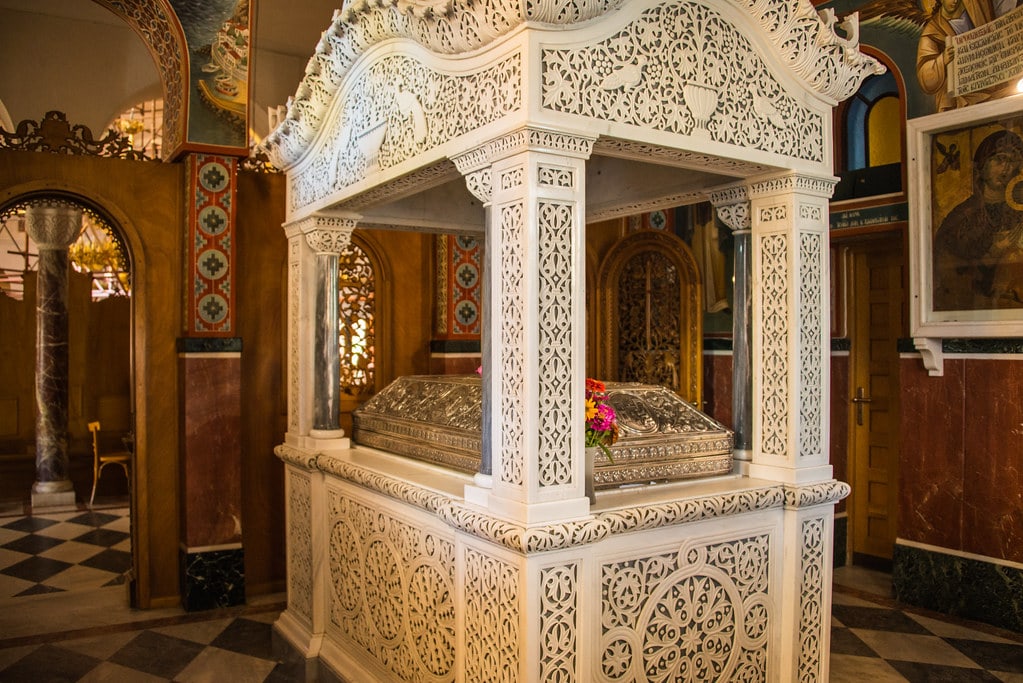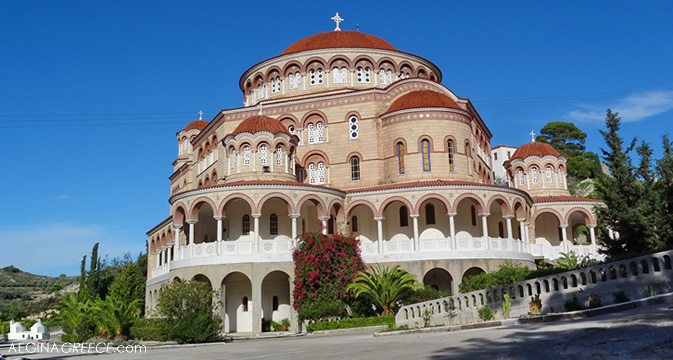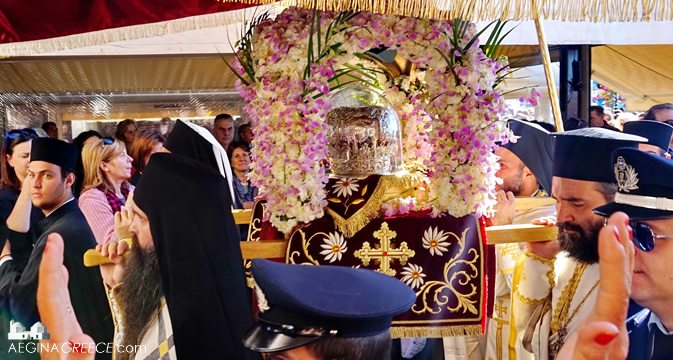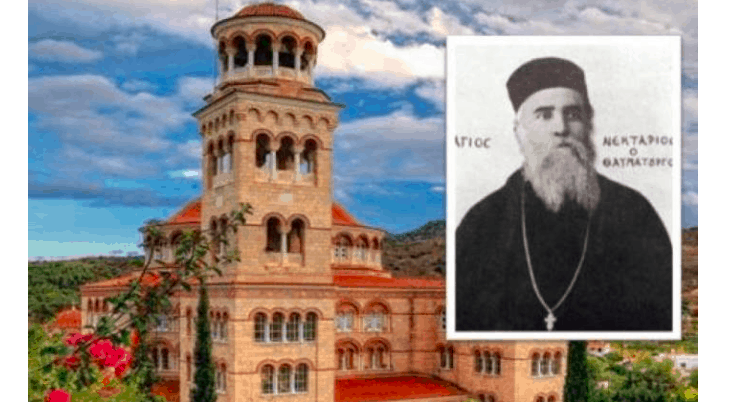Agios Nektarios of Aegina (1846-1920) is one of the most widely known Greek Orthodox Saints. The Ecumenical Patriarchate of Constantinople officially recognised him as a saint in 1961. Yearly, thousands of people from all over the world go to Aegina to visit the tomb of Agios Nektarios for healing reasons, to pray to him, or to ask for his blessings.

Agios Nektarios was known as a great miracle worker, particularly as a healer of every sort of disease. He was also a prolific writer, theologist, philosopher, moralist, educator, poet, ascetic, and mystic. Above all, Agios Nektarios was a man of deep prayer and a hard worker who laboured just as everyone else around him; no work was ever dishonorable to him.
Many despised him, mistaking his popularity amongst the people for an attempt to become patriarch. As such, he was relegated.

In 1904, at the request of several nuns, he established a monastery for women in Aegina named The Holy Trinity, where he lived as a monk for the rest of his life. He wrote, published, preached, and heard confessions from those who came from near and far to seek out his spiritual insights. In 1920, he died at the age of 74.
Agios Nektarios of Aegina is one of the most widely known Greek Orthodox Saints. He was born on October 1st, 1846, in Silyvria, Asia Minor.
At Holy Baptism, he was given the name Anastasios. His parents were simple, pious Christians. They brought him up in a manner pleasing to God and did what their very limited means allowed for his formal education. Having completed elementary school in his hometown, he left for the great city of Constantinople at the age of 14. There, he found employment as a shop assistant and could earn a meagre living. He also regularly attended the Divine Liturgy and read the Holy Scriptures and Writings of the Holy Fathers of the Church daily. From his wide reading, the young Anastasios made a collection of wise sayings, which he fervently spread to the customers of his store by writing them on the paper used to wrap their goods. He was selected to teach the lower grades of the orphanage of the All-Holy Sepulchre in Constantinople. This allowed him to continue his studies, for he longed to become a Theologian.

In 1866, at age 20, Anastasios went to the island of Chios, where he was appointed a teacher. After seven years, he entered the local monastery under the care of the venerable elder Pachomios. After three years as a novice, Athanasios was tonsured a Monk and given the name Lazarus. A year later, he was ordained a Deacon and received the name Nektarios. Elder Pachomios and a wealthy local benefactor convinced the young monk to complete his high school studies in Athens. From there, Deacon Nektarios went to Alexandria, where he was cared for by the Patriarch of Alexandria, Sophronios. The Patriarch insisted that Nektarios complete his Theological studies, so in 1885, he graduated from the School of Theology in Athens. The Patriarch of Alexandria ordained Deacon Nektarios to the Priesthood in 1886. His great service to the Church, prolific writings and teachings, energy and zeal led Fr Nektarios to be ordained as the Metropolitan of Pentapolis in Egypt.
As a Metropolitan, his flock greatly admired and loved him for his virtue and purity of life. But this great admiration by the people aroused the envy of certain high officials, who plotted and succeeded in having the Blessed Metropolitan removed from office in 1890 - without a trial or explanation. He returned to Greece to become a monk and Preacher, to the great edification of the people. There, the Blessed Metropolitan continued to write his famous books. In 1894, the divine Nektarios became Director of the Rizarios Ecclesiastical School, where he was to remain for 15 years. As an educator, the chief concern of the venerable Hierarch was to incite and guide youth to become good Christians. His fifteen years at Rizarios were also productive for writing many more books and teachings.

In 1904, Agios Nektarios founded a monastery for women in Aegina, the Holy Trinity Convent. Under his guidance, the Convent flourished. In 1908, the Blessed Nektarios, at the age of 62, retired from the Rizarios Ecclesiastical School and withdrew to Holy Trinity Convent in Aegina. There, he was a true monk and ascetic for the rest of his life. He served as a confessor and spiritual guide to the nuns and even priests from as far as Athens and Piraeus. His Holy and pious life shone like a guiding light to all near him. Many would come to him for healing. AgiosNektarios was a great ‘Wonder-worker’ even while alive.
On September 20, 1920, one of the nuns took him to the local hospital despite his protest. He was convulsing in pain from a long-standing ailment. He was admitted and placed into a ward reserved for the poor and unwanted. There, he stayed for two months among the sick and dying. At 10:30 in the evening of November 8th, although amid terrible pains, in peace and at prayer, he gave up his spirit unto God at 74.
When the Saint gave up his Spirit, a nurse came to prepare him for transfer to Aegina for burial. As the nurse removed the Saint's sweater, she inadvertently placed it on the next bed, on which a paralytic lay. And O, strange wonder! The paralytic immediately began to regain his strength and arose from his bed healthy and glorifying God.

Sometime after his repose, strangely, a beautiful fragrance was emitted by his Holy body, filling the room. Many came to venerate his Holy relics before his burial. Amazingly, people noted a fragrant fluid that drenched his hair and beard. Even after five months, when the convent's nuns opened the Saints grave to build a marble tomb, they found the Saint intact in every respect and emitted a wonderful and heavenly fragrance. Similarly, the Holy Relics were still whole three years later, radiating the same heavenly fragrance.
Many people regarded Nektarios as a Saint while he was still alive because of his purity of life, virtues, the nature of his publications, his gift of foreknowledge, and the miracles he performed. The recognition of him as a Saint spread rapidly after his repose. God confirmed the Sanctity of Nektarios at his repose and by the miracles attributed to the Saint after his repose. The Orthodox Church proclaimed him as a Saint on April 20, 1961. The Church celebrates His Blessed Memory on November 9th.
One of the most visited sites on Aegina is the church of Agios Nektarios and the monastery of Agia Triada (The Holy Trinity), located on a higher level overlooking the church.
*Main Source: Aegina Greece
Travelling to Aegina: The best places to eat at

